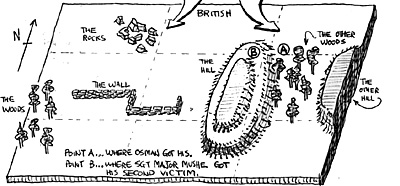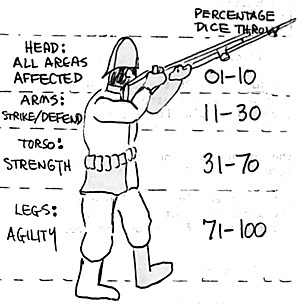We killed about an hour and a half the other day with a quick set of British colonial skirmish rules. I had listed, on an assortment of 3x5 cards, the attributes of two patrols: 5 British and 10 natives.
The cards were shown, cold turkey, as we say, to Terry Sirk, Fred Haub, and my son Warren -- and 10 minutes later, based solely on the characteristics I had listed, we were engaged in our skirmish. Now you can't ask for a faster reaction than that! How fast can YOU generate rules??
Each man had 4 attributes; the card for Osman the Skull Smasher is shown in Figure 1. The highest number of points per characteristic was 25 ... hence Osman, with his 23, started out fairly strong.
The lowest number of points was 15 ... it may be seen that, other than a strong pair of hands, Osman was not too wonderfully endowed.
The reason I displayed the Skull Smasher's card was that poor Osman closed to combat with Sgt Major Mushe, and was promptly strangled for his trouble!
Figure 1
OSMAN THE SKULL SMASHER
- STRENGTH: 23
AGILITY: 18
WEAPONRY
- STRIKE : 15
DEFEND: 15
Figure 2
SERGEANT MAJOR MUSHE
- STRENGTH: 20
AGILITY: 16
WEAPONRY:
- STRIKE: 25
DEFEND: 25
The Sergeant's card is shown in Figure 2; note that he, as all the British, commenced with 25 points as his weaponry factors... well trained, these Brits.
During the encounter, Sgt Major Mushe was the target of several volleys from the natives. A series of dice throws rapidly reduced the Sergeant's attributes in every area but STRENGTH ... hence when the Sergeant reached the wooded region - see Figure 3 - in which Osman lie awaiting, Mushe's leading factor was his 20 STRENGTH points, and he chose not to fire at Osman, but to close and grapple with him.
Poor Osman, during the Sergeant's advance, had himself taken a hit or two ... I say "poor" Osman because, by the time Mushe reached him, the dice had reduced Osman's STRENGTH to 11. Odds of 20 to 11 were too much for Osman, and when Mushe finished with him, the Skull Smasher would smash skulls no more.
More Mushe
 Elated by the relative ease with which he had wrung Osman's neck,
Mushe charges up the hill and throttled yet another native! A good man,
that Mushe.
Elated by the relative ease with which he had wrung Osman's neck,
Mushe charges up the hill and throttled yet another native! A good man,
that Mushe.
Each side's factors were kept from the opponents, hence no one knew what relative skill strengths he was up against when close combat occurred. When 2 men closed, each chose one tactic from the following group:
- 1. He could STRIKE with his weapon.
2. He could DEFEND with his weapon.
3. He could rush up to close, and overpower with his STRENGTH.
4. He could jump back, i.e., disengage, with his AGILITY.
The resulting matrix of opposing tactics thus paired off the various attributes. If, for example, both tried to overpower each other, each threw a 10-sided die:
- Combat Points = (10-sided die roll) x (STRENGTH)
and the man with the higher value scored on his opponent.
 Percentage dice were then thrown as shown in Figure 4 to determine
where the target was affected, and a 10-sided die determined how many
points were taken off the particular attribute that had been hit.
Percentage dice were then thrown as shown in Figure 4 to determine
where the target was affected, and a 10-sided die determined how many
points were taken off the particular attribute that had been hit.
Another example would be if one man decided to close to STRIKE with his weapon, while the other tried to jump back with all the AGILITY at his command. Here, each factor would be multiplied by the 10-sided die.
If the STRIKE was successful. i.e,, the STRIKE Combat Points greater than the AGILITY Points, Figure 4 was used ... whereas if AGILITY won out, the parties were disengaged.
A third example would be if one man chose to STRIKE while his opponent rushed in to overpower him with his STRENGTH. The sequence would be:
- (a) The man opting for STRIKE gets a chance to whomp the rusher.
For a successful STRIKE: Percentage Dice Throw less than or equal to 4
x STRIKE
- Note that, initially, all Brits would score perfect STRIKES with
their weapons, since 4 x 25 = 100%
(b) If the STRIKE was successful, points were taken off the charging man ala Figure 4, and he checked to see if he remained on his feet:
- Percentage dice Throw less than or equal to 4 x STRENGTH
(c) If the fellow passed, he could then attempt to throttle the man who had smitten him:
- Percentage Dice Throw less than or equal to 4 x STRENGTH
(d) And if this was successful,that is, if the smitten smote the smiter, Figure 4 was again used for further wounds to the original STRIKE parity, and he then checked to see If he kept his feet:
- Percentage Dice Throw less than or equal to 4 x STRENGTH
Other pairings of attributes on the melee matrix were similarly resolved. Sergeant Muske's STRIKE points, due to his wounds, when he reached Osman, totaled only 5 'twas no wonder he chose to abandon his weapon and go for the throat.
Movement and other activities were governed by an "incremental" card deck. Each side had Its own selection of cards; three were in the hand, the rest face down, and when one was played, another was picked to replenish the three in the hand.
Men could move 4 inches per increment. The choice on a 3 increment card could be to fire twice and move, or move 3 times (12 inches), or move/fire/move/ and so on.
The card allocation per deck was:
| No of Cards | No of Increments |
|---|---|
| 3 | 1 |
| 5 | 2 |
| 3 | 3 |
| 11 cards total | |
An attacker moved up just short of contact on his card. On the defender's card, the defender got to fire with his STRIKE points, the attacker checked STRENTH to see if he remained on his feet, and if he did, he closed and a combat was fought.
The British came running on the field from the north baseline ; the natives, however, could be pre-positioned... to a degree.
The field was divided into 9 large areas as the dotted lines in Figure 3 show. Once the game started, natives would be placed in whatever area the native commander wished. A 6-sided die, per turn, told of how many natives would appear that turn.
There were 2 restrictions to native placement, however:
- a. Once a British trooper reached a dotted area, no natives could
initially be placed there. Thus the Brits wanted to spread out quickly at first,
covering their 3 baselines, preventing the natives from popping up at close
range.
b. The native commander would point to a spot and state: "Achmed will appear here." But Achmet only had a 30% chance of appearing where his boss wanted him to... and if he didn't, the sum of two 10-sided dice indicated how many inches away slothful Achmed really was from his appointed place.
Firing
The firing procedure accounted for 3 basic factors:
- Number of rounds fired: N
Range: R
Weapon expertise: STRIKE
P(Hit)= (10 X N)+(STRIKE points)-(Range)
Note that each round fired increased the probability of hit by 10%. A maximum of 10 rounds per volley was permitted each man per increment. Thus on a 3 incremental card, a man could fire 3 separate volleys, expending 30 rounds total.
Each man was equipped with 50 rounds for the battle.
For the British, the STRIKE points were doubled in the P(hit) equation, while a native used the figure directly listed on his chart. If the target was under cover, P(Hit) was halved.
Reaction to the game was kinda interesting. I, as the umpire, found it fascinating as the opposing parties matched off their best attributes. My son, who ran the natives, found it "boring", but then my son finds everything "boring"... from small tribal massacres to planetary nuclear holocausts.
Fred confined himself to recording and updating the British data cards, muttering unkind thoughts about all the bookkeeping requirements. Terry, as British commander, seemed to find it as engrossing as I did.
Can you please everyone all the time? Silly question. Did Osman die in vain? Probably not, since our next set of British colonial skirmish rules are on the way.
Back to PW Review March 1985 Table of Contents
Back to PW Review List of Issues
Back to MagWeb Master Magazine List
© Copyright 1985 Wally Simon
This article appears in MagWeb (Magazine Web) on the Internet World Wide Web.
Other military history articles and gaming articles are available at http://www.magweb.com